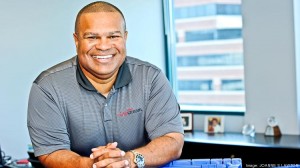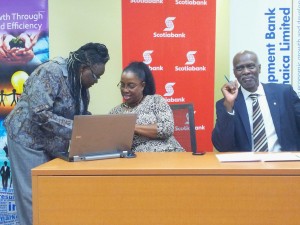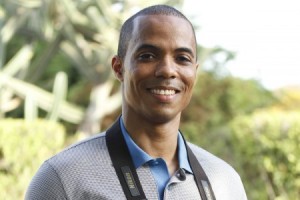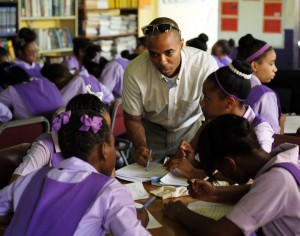
Young Scientists in Jamaica Need “More Love”
November 26th, 2015
How can we nurture science and technology in Jamaica? How can we inject a new vigor and build genuine support for the sector?
A couple of recent conversations gave me pause for thought. A few days ago I attended a discussion co-hosted by the University of the West Indies’ (UWI) Biotechnology Centre and Katalyxt on the theme: “Dimensions: Jamaica’s Agricultural Biotechnology Marketplace.” Graduate students from the Biotechnology Centre (some a little unsure of themselves, but nevertheless enthusiastic) made short presentations on their research that is leading to the development of products – all apparently quite marketable. The students were guided and nurtured by the Centre’s Executive Director, Professor Helen Asemota, who was, clearly and understandably, proud of their progress so far.

Jamaican Kevin Reid, co-Founder, President & CTO of Virtustream, Inc., found huge success in the Silicon Valley IT era. Now, says Douglas Orane, we are in the biotechnology era. (Photo: bizjournals.com)
Retired businessman (former CEO and Chairman of GraceKennedy) Douglas Orane told the students that they were in the right place at the right time. Noting the tremendous achievements of two Jamaicans in the dazzling world of Silicon Valley (Kevin Reid of Virtustream and Lloyd Carney of Brocade Communications Systems) Mr. Orane reminded them that biotechnology is now “the field of the future.” So the students need to be up for it, brains sharp and test tubes at the ready.
The students told us about the business ventures they are embarking on – not yet fully fledged but in late development stages. There is Phyto-bioFoods (“food for plants”), which is a two-in-one organic fertilizer and insecticide. We also heard about the anti-cancer properties of the Purple Yam – Dioscorea alata (also called the St. Vincent or Moonshine Yam), discovered last year by Dr. Dennis Bailey while he was researching for his Doctorate. Two students, Shiva and Princess, told us about the snacks and foods they are producing from excess yam cuttings (when the vendor cuts a piece off to give you a clean piece of yam), with names like “Yamoroni” (à la macaroni). We also heard about candles and soaps made from the neem tree, which repels insects, and garlic cough syrup, produced by Jamaica Herbal.

Biotech meets business: Professor Helen Asemota (left) and Katalyxt’s Winsome Minott while businessman Dalma James looks on. (My photo)
There was much discussion about how to market products, establish financial reliability and trust, “scale up” production and move your business forward, with much guidance and sensible advice from Mr. Orane. Then Professor Asemota observed that, while female students at the Biotechnology Centre tend to love science for its own sake, the men are “more interested in the business side” – its practical applications, in other words. The professor emphasized: “Many of my students struggled through their undergraduate years.” These are not just financial struggles – although those are hard enough; it is emotional and moral support, if you like that is also falling short. Professor Asemota’s students, especially those with entrepreneurial leanings (including those who presented to us) have stayed focussed despite the odds against them. But…“Students need mentorship,” the professor stressed.
This led to a wider-ranging discussion on mentorship. As Mr. Orane pointed out, it “must be planned and organized.” The ad hoc approach is simply a recipe for failure in the short term. The word “mentorship” sounds great when it is bandied about, but making it work is another matter. Mentorship involves commitment (in particular, that of time), a great deal of patience, and yes – planning. It cannot be done half-heartedly. It needs to be an integral part of the mentor and mentee’s calendars, I would say. Mr. Orane, who has been mentoring a student at his alma mater for the past few years, notes the importance of finding an “emotional connection.” Therefore, he suggested, a past Biotechnology Centre student might be the ideal fit to mentor a current undergraduate there.
But is this happening? It appears that many (not all) UWI graduates have not been coming forward to “give back” to their alma mater through mentorship and these kinds of individual connections. However, such interactions will strengthen the institution that they studied at and benefited from, for future generations. Why the reticence? It was not clear to me from this conversation. Suffice it to say that there are many potential mentees, but few mentors. At both UWI and the University of Technology (UTech) I know there are established mentorship programs, but how substantial are they? Do we need to look at mentorship in a different way? Mr. Orane pointed out that Silicon Valley thrived on its relationship with nearby Stamford University. In the United States, for some reason, this seems to be a more natural symbiosis (there, I used a scientific word, I hope correctly!) Why not in Jamaica?
So, this all made me wonder whether support for the strengthening of science education and research is actually happening at the various levels that it needs to happen; or whether it is merely lip service by a few leaders, political and otherwise. “STEM” is a nice-sounding acronym.

Smithsonian Fellow Dr. Leo Douglas is conducting a long-term study of changing behaviors and attitudes towards conservation among Jamaican high school students. (Photo: BirdsCaribbean)
Just recently, an observation by the Jamaican President of BirdsCaribbean Dr. Leo Douglas raised some questions in my mind. At the Annual General Meeting of BirdLife Jamaica, Dr. Douglas gave us a talk on the progress of his project in Jamaican high schools, as a Smithsonian Fellow at the National Zoological Park in Washington, D.C. The fellowship funds his study on the knowledge, attitudes and practices of the students towards nature conservation, including how they are affected by culturally relevant environmental education programs. This is the first long-term study of its kind in the western hemisphere. By the way, did you know that scientists from the Migratory Bird Center at the Smithsonian have been conducting research in Jamaica for the past twenty or thirty years, quietly coming and going? Such is the nature of science: collaboration.
The questionnaire that Dr. Douglas gave the students, one year after the first they had completed, turned up some encouraging results in terms of their increased awareness and knowledge. Dr. Douglas is curious about one particular response, though: When asked “would you consider becoming a wildlife scientist one day?” the students expressed no more interest than in the previous year. They were equally lukewarm. What, if anything can one conclude from this? It is too early to say – but could it be that the word “scientist” scared them off, a little? Is there a negative perception of science among young people, instilled by parents and teachers who still believe in the “lawyer/doctor/engineer” career path?
Businessman Dalma James observed during the Katalyxt seminar: “We always underestimate the capacity of young people.” Let us open their minds, encourage innovation and creativity. And when it comes to science, let’s put our money where our mouth is and actively support this field – especially our young postgraduate researchers, who are busy breaking new ground.
To echo Mr. Orane’s words, science and technology is the future. Time for Jamaica to embrace the future.
Tags: agriculture, biotechnology, Biotechnology Centre, BirdLife Jamaica, BirdsCaribbean, conservation, Dalma James, Dennis Bailey, Douglas Orane, entrepreneurs, GraceKennedy, Helen Asemota, high schools, Katalyxt Jamaica, Leo Douglas, mentorship, purple yam, science, Smithsonian Institution, STEM, University of Technology, University of the West Indies, yam
The Gleaner reserves the right not to publish comments that may be deemed libelous, derogatory or indecent.
To respond to The Gleaner please use the feedback form.
- We Are the Zoomers
- Living Online with Humans and Birds: NAOC 2020
- Human Trafficking and the Problem of Public Education
- Down Memory Lane
- Are We Ready to Recover from COVID-19?
- Road Safety Matters: Is Your Vehicle Safe?
- Sexual Harassment, Me Too, and the Minister’s Disturbing Giggle
- The Vulnerable Senior Citizens, Private Care Homes and COVID-19
- A Muddle Over Masks
- Here is Something Life-Saving You Can Do: Give Blood!



